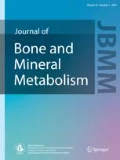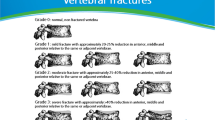Abstract
Introduction
Prostate cancer often forms osteoblastic lesions that appear as a high-dense shadow upon X-ray. Although the lesions may seem to increase bone strength, pathological fracture occurs in one in four patients with prostate cancer. The aim of this study is to elucidate the factors that may increase the risk of pathological fracture in patients with prostate cancer metastases in the proximal femur by analyzing computed tomography data.
Materials and methods
Computed tomography data of the femur of 62 prostate cancer patients were retrospectively analyzed. The patients were divided into three groups based on the presence or absence of femoral metastatic lesions and pathological fracture. Surgical specimens of the proximal femur collected from patients who had a pathological fracture were histologically analyzed.
Results
Bone density in the marrow area was increased in all cases with metastases compared with those with no metastases. Contrarily, the cortical bone density at the medial trochanter region was significantly lower in patients who had pathological fractures in the proximal femur than those who did not. Accordingly, histological analysis of the surgical specimens revealed that the affected cortical bone was osteopenic without any apparent new bone formation.
Conclusion
These results indicate that prostate cancer is less effective in inducing bone formation in the cortex than in the marrow and that the decrease in the cortical bone density at the medial trochanter region leads to an increased risk of pathological fracture. Therefore, a previously undocumented risk factor for pathological fracture in prostate cancer patients is presented.





Similar content being viewed by others
References
Litwin MS, Tan HJ (2017) The diagnosis and treatment of prostate cancer: a review (in eng). JAMA 317:2532–2542. https://doi.org/10.1001/jama.2017.7248
Hamdy FC, Donovan JL, Lane JA, Mason M, Metcalfe C et al (2016) 10-Year outcomes after monitoring, surgery, or radiotherapy for localized prostate cancer. N Engl J Med 375:1415–1424. https://doi.org/10.1056/NEJMoa1606220
Barry MJ, Simmons LH (2017) Prevention of prostate cancer morbidity and mortality: primary prevention and early detection (in eng). Med Clin North Am 101:787–806. https://doi.org/10.1016/j.mcna.2017.03.009
Coleman RE (2006) Clinical features of metastatic bone disease and risk of skeletal morbidity. Clin Cancer Res 12:6243s-s6249. https://doi.org/10.1158/1078-0432.CCR-06-0931
Coleman RE (1997) Skeletal complications of malignancy (in eng). Cancer 80:1588–1594. https://doi.org/10.1002/(sici)1097-0142(19971015)80:8+%3c1588::aid-cncr9%3e3.3.co;2-z
Logothetis CJ, Lin SH (2005) Osteoblasts in prostate cancer metastasis to bone. Nat Rev Cancer 5:21–28. https://doi.org/10.1038/nrc1528
Saad F, Gleason DM, Murray R, Tchekmedyian S, Venner P, Lacombe L, Chin JL, Vinholes JJ, Goas JA, Zheng M, Zoledronic Acid Prostate Cancer Study G (2004) Long-term efficacy of zoledronic acid for the prevention of skeletal complications in patients with metastatic hormone-refractory prostate cancer. J Natl Cancer Inst 96:879–82. https://doi.org/10.1093/jnci/djh141
Hagiwara M, Delea TE, Saville MW, Chung K (2013) Healthcare utilization and costs associated with skeletal-related events in prostate cancer patients with bone metastases. Prostate Cancer Prostatic Dis 16:23–27. https://doi.org/10.1038/pcan.2012.42
Saad F, Gleason DM, Murray R, Tchekmedyian S, Venner P, Lacombe L, Chin JL, Vinholes JJ, Goas JA, Chen B, Zoledronic Acid Prostate Cancer Study G (2002) A randomized, placebo-controlled trial of zoledronic acid in patients with hormone-refractory metastatic prostate carcinoma (in eng). J Natl Cancer Inst 94:1458–68. https://doi.org/10.1093/jnci/94.19.1458
Oefelein MG, Ricchiuti V, Conrad W, Resnick MI (2002) Skeletal fractures negatively correlate with overall survival in men with prostate cancer. J Urol 168:1005–1007. https://doi.org/10.1097/01.ju.0000024395.86788.cc
Weinfurt KP, Li Y, Castel LD, Saad F, Timbie JW, Glendenning GA, Schulman KA (2005) The significance of skeletal-related events for the health-related quality of life of patients with metastatic prostate cancer. Ann Oncol 16:579–584. https://doi.org/10.1093/annonc/mdi122
Mirels H (2003) Metastatic disease in long bones: a proposed scoring system for diagnosing impending pathologic fractures. 1989. Clin Orthop Relat Res. https://doi.org/10.1097/01.blo.0000093045.56370.dd
van der Linden YM, Kroon HM, Dijkstra SPDS, Lok JJ, Noordijk EM, Leer JWH, Marijnen CAM (2003) Simple radiographic parameter predicts fracturing in metastatic femoral bone lesions: results from a randomised trial. Radiother Oncol 69:21–31. https://doi.org/10.1016/s0167-8140(03)00232-9
Damron TA, Nazarian A, Entezari V, Brown C, Grant W, Calderon N, Zurakowski D, Terek RM, Anderson ME, Cheng EY, Aboulafia AJ, Gebhardt MC, Snyder BD (2016) CT-based structural rigidity analysis is more accurate than mirels scoring for fracture prediction in metastatic femoral lesions. Clin Orthop Relat Res 474:643–651. https://doi.org/10.1007/s11999-015-4453-0
Benca E, Patsch JM, Mayr W, Pahr DH, Windhager R (2016) The insufficiencies of risk analysis of impending pathological fractures in patients with femoral metastases: a literature review. Bone Rep 5:51–56. https://doi.org/10.1016/j.bonr.2016.02.003
Damron TA, Morgan H, Prakash D, Grant W, Aronowitz J, Heiner J (2003) Critical evaluation of Mirels’ rating system for impending pathologic fractures. Clin Orthop Relat Res. https://doi.org/10.1097/01.blo.0000093842.72468.73
Tatar Z, Soubrier M, Dillies AF, Verrelle P, Boisgard S, Lapeyre M (2014) Assessment of the risk factors for impending fractures following radiotherapy for long bone metastases using CT scan-based virtual simulation: a retrospective study. Radiat Oncol 9:227. https://doi.org/10.1186/s13014-014-0227-1
Roudier MP, Morrissey C, True LD, Higano CS, Vessella RL, Ott SM (2008) Histopathological assessment of prostate cancer bone osteoblastic metastases. J Urol 180:1154–1160. https://doi.org/10.1016/j.juro.2008.04.140
Morrissey C, Roudier MP, Dowell A, True LD, Ketchanji M, Welty C, Corey E, Lange PH, Higano CS, Vessella RL (2013) Effects of androgen deprivation therapy and bisphosphonate treatment on bone in patients with metastatic castration-resistant prostate cancer: results from the University of Washington Rapid Autopsy Series. J Bone Miner Res 28:333–340. https://doi.org/10.1002/jbmr.1749
Currey JD (2002) The structure of bone tissue. Bones: structure and mechanics. Princeton University Press, Princeton, pp 12–14
Garden RS (1961) Low-angle fixation in fractures of the femoral neck. J Bone Joint Surg Br 43-B:647–63. https://doi.org/10.1302/0301-620X.43B4.647
Garden RS (1961) The structure and function of the proximal end of the femur. J Bone Joint Surg Br 43-B:576–89. https://doi.org/10.1302/0301-620X.43B3.576
Rudman KE, Aspden RM, Meakin JR (2006) Compression or tension? The stress distribution in the proximal femur. Biomed Eng Online 5:12. https://doi.org/10.1186/1475-925X-5-12
Treece GM, Gee AH, Tonkin C, Ewing SK, Cawthon PM, Black DM, Poole KE, Osteoporotic Fractures in Men S (2015) Predicting hip fracture type with cortical bone mapping (CBM) in the osteoporotic fractures in men (MrOS) study. J Bone Miner Res 30:2067–77. https://doi.org/10.1002/jbmr.2552
Poole KES, Skingle L, Gee AH, Turmezei TD, Johannesdottir F, Blesic K, Rose C, Vindlacheruvu M, Donell S, Vaculik J, Dungl P, Horak M, Stepan JJ, Reeve J, Treece GM (2017) Focal osteoporosis defects play a key role in hip fracture. Bone 94:124–134. https://doi.org/10.1016/j.bone.2016.10.020
Acknowledgements
The authors would like to thank Takemi Oguma (Department of Orthopedic Surgery, National Defense Medical College), Ruu Hokari (Department of Basic Pathology, National Defense Medical College), Fumiko Hamabe, Ayako Mikoshi (Department of Radiology, National Defense Medical College), and Shinsuke Tasaki (Department of Urology, National Defense Medical College) for their technical assistance.
Funding
Japan Society for the Promotion of Science, 9K09613, Kazuhiro Chiba
Author information
Authors and Affiliations
Contributions
HR: designed the study, performed most of the experiments, analyzed the data, and wrote the manuscript. KH: supervised the project, designed the study, and wrote the manuscript. MS and KC: supervised the project. MI, ET, and TI: assisted with the analysis.KM: performed the histological analysis.
Corresponding author
Ethics declarations
Conflict of interest
The authors have no conflict of interests to declare.
Additional information
Publisher's Note
Springer Nature remains neutral with regard to jurisdictional claims in published maps and institutional affiliations.
About this article
Cite this article
Rikitake, H., Horiuchi, K., Miyai, K. et al. Risk assessment of femoral pathological fracture in prostate cancer patients by computed tomography analysis. J Bone Miner Metab 40, 704–711 (2022). https://doi.org/10.1007/s00774-022-01338-2
Received:
Accepted:
Published:
Issue Date:
DOI: https://doi.org/10.1007/s00774-022-01338-2




